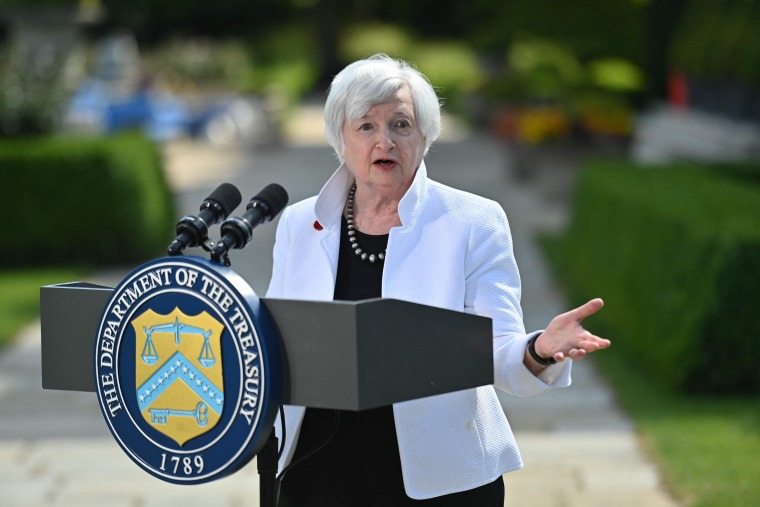In making the case for President Joe Biden’s ambitious $4 trillion in spending proposals, Treasury Secretary Janet Yellen said policymakers should learn to get comfortable with the idea of a moderate amount of inflation, even if that means higher rates.
“If we ended up with a slightly higher interest rate environment, it would actually be a plus for society’s point of view and the Fed’s point of view,” Yellen said in a Bloomberg News interview on Sunday. “We’ve been fighting inflation that’s too low and interest rates that are too low now for a decade.”
In arguing that the fear of interest-rate creep is overblown, Yellen is affirming the stance taken by Federal Reserve Chairman Jerome Powell that price increases are transitory and — so far, at least — remain within the central bank’s policy target.
“Higher interest rates in and of themselves are not necessarily good for consumers. But if it's the result of successful implementation of fiscal policy, Yellen and other Democrats are arguing that's perfectly OK,” said Ben Koltun, director of research at Beacon Policy Advisors.
But economists have raised concerns, with some suggesting that growth models healthy enough to support a reasonable amount of inflation are overly optimistic.
“If the economy was really rapidly booming, rates would naturally rise, but that's not the case,” said Joseph LaVorgna, managing director and chief economist of the Americas at Natixis. “To get rates higher, you need to have a robust economy.”
The pandemic’s impact on consumer behavior distorted spending on durable goods by pulling it forward, LaVorgna said. He predicted that even increased consumption of services in the coming quarters might not be enough to fill that gap, since an indeterminate amount of service-sector spending could remain depressed if Americans remain reluctant to engage in activities with high levels of interpersonal contact.
Higher interest rates could ripple through the housing market — which is already facing higher prices driven by supply constraints — and lead to higher borrowing costs across the board. Ted Rossman, senior industry analyst for CreditCards.com, said that even with the Fed’s benchmark interest rate near zero, credit card customers haven’t really benefited.
“As much as we've been talking about a record-low interest rate environment, that has not extended to credit cards,” he said, adding that the average APR for new card accounts is a little over 16 percent. If the Fed had to sharply hike interest rates to rein in inflation, borrowers could see the cost of servicing their revolving debt jump, too.
LaVorgna hypothesized that Senate rules limiting how much spending congressional Democrats could push through without bipartisan support ultimately could lead to negotiations that significantly pare the size and scope of Biden’s economic agenda.
“That suggests to me that whatever bill gets passed is … going to be smaller. That’s going to support lower rates for two reasons,” he said, since Wall Street expectations will be tempered and the Fed will be inclined to continue its course of accommodative monetary policy.
Such a high degree of uncertainty has prompted policymakers to re-evaluate their assumptions about the best methods to sustain the recovery.
“There has been a paradigm shift of the fiscal versus monetary policy debate in the Democratic policy world of how best to boost the economy,” Koltun said. In the past, “monetary policy was seen as the primary force of economic growth,” but today, “there are limits in a low rate world of what monetary policy can do,” he said.
The key limitation of monetary policy is that the Federal Reserve has the power to lend but not spend, as the adage goes, which has prompted the Biden administration and most Democratic lawmakers to embrace an unprecedented experiment in stimulative fiscal policy.
“Yellen is advocating for a robust fiscal policy with the American Jobs Plan and American Families Plan, as well as defending the $1.9 trillion American Rescue Plan,” Koltun said.
Yellen has recently sought to reframe this total of $6 trillion in proposed spending, telling Bloomberg, “They’re not meant as stimulus, they’re meant as investments to address long-standing needs of our economy.”
Former Treasury Secretary and National Economic Council director Larry Summers has been one of the most prominent Democratic establishment figures warning of the potential risk of runaway inflation. Summers called overheating “the primary risk to the U.S. economy” in a Washington Post opinion column last month titled, “The Inflation Risk Is Real.”
“While continuing relief efforts are essential, the focus of our macroeconomic policy needs to change,” he wrote, pointing to recent increases in consumer prices and inflation expectations. “The history here is not encouraging. Every time the Fed has hit the brakes hard enough to slow growth meaningfully, the economy has gone into recession.”
Yellen, a former Federal Reserve Chair herself, has expressed confidence that Powell’s Fed can avoid this fate — a show of faith that could ultimately define her legacy at the helm of the Treasury Department.
“It’s always an expectations game,” Koltun said. “This is something that can be very hard for the Federal Reserve to control.”
